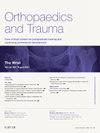微创足部手术:什么是微创足部手术?它的优点和缺点是什么?
Q4 Medicine
引用次数: 0
摘要
微创手术(MIS)是指使用专门的设备通过小切口进行的手术。它包括范围广泛的手术,如关节镜以及经皮软组织或骨矫正手术。由于缺乏对适当设备、术中成像和适当固定重要性的认识,MIS历来与高并发症发生率相关。这些问题已经通过更好的器械,更好的内固定截骨技术得到解决,从而改善了MIS的预后。最近的系统综述将MIS与开放手术进行了比较,结果相似,并且在创伤和择期情况下都具有更低的伤口并发症发生率和更短的住院时间。总体证据仍然相对缺乏,仍然需要长期的结果研究。与开放式技术相比,MIS的主要缺陷包括陡峭的学习曲线以及更高的金属工件去除率。也有技术上的陷阱,特别是在进行外翻手术时。本文章由计算机程序翻译,如有差异,请以英文原文为准。
Minimally invasive foot surgery: what is it and what are the gains and pitfalls?
Minimally invasive surgery (MIS) describes surgery performed using specialized equipment through small incisions. It includes a wide range of surgery such as arthroscopy as well as percutaneous soft tissue or bony corrective surgery. MIS has been associated with a high complication rate historically from a lack of understanding the importance of appropriate equipment, intraoperative imaging and appropriate fixation. These have been addressed with better instruments, better osteotomy techniques with internal fixation which have improved the outcomes of MIS. Recent systematic reviews comparing MIS with open surgery show similar outcomes with the added benefit of lower wound complication rate and shorter hospital stays in both the trauma and elective settings. Overall evidence is still relatively poor and long-term outcome studies are still needed. The main pitfalls with MIS include a steep learning curve as well as higher metal work removal rate compare to open techniques. There are also technical pitfalls especially when performing hallux valgus surgery.
求助全文
通过发布文献求助,成功后即可免费获取论文全文。
去求助
来源期刊

Orthopaedics and Trauma
Medicine-Orthopedics and Sports Medicine
CiteScore
1.00
自引率
0.00%
发文量
57
期刊介绍:
Orthopaedics and Trauma presents a unique collection of International review articles summarizing the current state of knowledge and research in orthopaedics. Each issue focuses on a specific topic, discussed in depth in a mini-symposium; other articles cover the areas of basic science, medicine, children/adults, trauma, imaging and historical review. There is also an annotation, self-assessment questions and a second opinion section. In this way the entire postgraduate syllabus will be covered in a 4-year cycle.
 求助内容:
求助内容: 应助结果提醒方式:
应助结果提醒方式:


